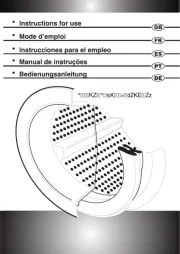Indesit IDV 75 (KW) Handleiding
Indesit
Wasdrogers
IDV 75 (KW)
Bekijk gratis de handleiding van Indesit IDV 75 (KW) (10 pagina’s), behorend tot de categorie Wasdrogers. Deze gids werd als nuttig beoordeeld door 69 mensen en kreeg gemiddeld 4.8 sterren uit 35 reviews. Heb je een vraag over Indesit IDV 75 (KW) of wil je andere gebruikers van dit product iets vragen? Stel een vraag
Pagina 1/10

1
EN
IDV 75
Instruction manual
TUMBLE DRYER
English, 1
EN
Français,41
FR
! This symbol reminds you to read this
instruction manual.
! Keep this manual at hand for immediate reference whenever
necessary. Always store this manual close to the tumble dryer and
remember to pass it on to any new owners when selling or tran-
sferring the appliance, so they may familiarise with the warnings
and suggestions herein contained.
! Read these instructions carefully: the following pages contain
important information on installation and useful suggestions for
operating the appliance.
www.indesit.com
Contents
Installation, 2
Where to install the tumble dryer
Ventilation
Electrical connections
Levelling the tumble dryer
Before you start your dryer
Warnings, 4
General safety
Saving energy and respecting the environment
Care and maintenance, 6
Disconnecting the power supply
Cleaning the filter after each cycle
Checking the drum after each cycle
Cleaning the tumble dryer
Description of the tumble dryer, 7
Front side
Rear side
Control panel
How to carry out a drying cycle
Starting a drying programme
Drying settings, 8
Drying times
Drying programmes and options
Troubleshooting, 9
Laundry
Assistance and Guarantee, 10
Spare parts
Information on recycling and disposal
1 ،ةيبرعلا
AR
AR

2
EN
Installation
10
m
m
15 mm
15 mm
15 mm
15 mm
B
A
Where to install the tumble dryer
If the dryer is installed below a worktop,
ensure there are 10 mm
between the upper panel
of the dryer and any
objects above it, and 15
mm between the sides
of the machine and the
walls or furniture units
adjacent to it. This en-
sures adequate air cir-
culation. Make sure the
air inlets on the rear panel are not blocked or
obstructed.
Ventilation
This appliance gently dries laundry by taking in cold, clean
and relatively dry air, heating it and passing it through the
fabric. To facilitate the drying process, damp air is expelled at
the rear, through a ventilation hose. When the dryer is in use,
there has to be adequate ventilation to avoid a back flow
of gases into the room from appliances burning other fuels,
including open fires.
Mobile ventilation system
When using the tumble dryer with the mobile ventilation
system, a ventilation hose must be connected. The hose
should be securely fastened to the ventilation hole at the
rear of the appliance (see “Description of the tumble dryer”).
We recommend the hose is connected to an outlet near
the tumble dryer, if possible. If it cannot be installed in a
permanent spot, the tumble dryer will still function perfectly
well if the ventilation hose is passed through a partially-
opened window.
Make sure you do not point the ventilation hose towards the
air inlet, which is located on the rear of the appliance.
The ventilation hose should not exceed a maximum length
of 2.4 metres; it should also be shaken frequently to remove
any fluff, dust or water deposits inside it. Make sure you do
not crush the hose.
Fixed ventilation system
We recommend the ventilation hose is connected to a
ventilation system for windows or doors, available from the
retailer which originally sold you the appliance or from your
local spare parts stockist.
Wall ventilation hole
1. Leave an opening in the wall to the left of the tumble dryer
installation site.
2. Make the hose as short and straight as possible, in order
to prevent any moisture from condensing and leaking back
into the appliance.
3. The hole in the wall must also be straight and pointing
downwards, so that the flow of air coming out is not
impeded.
Areas and should be checked frequently, to prevent A B
the accumulation of fluff or debris, particularly if the tumble
dryer is used very often. The hose adaptor must be fitted
correctly, in order to prevent damp air from coming back into
the room.
Window ventilation hole
The ventilation hole should be
directly behind the dryer in order
to keep the hose as short as
possible.
Make sure you do not push the
tumble dryer too far backwards,
as this could lead to the
ventilation hose being crushed,
bent or even disconnected.
There should be no cuts, kinks or “ ”-shaped bends U
in the hose, as these could impede ventilation or trap
condensation.
The end of the hose must be facing downwards, in order to
prevent the hot, damp air from forming condensation in the
room or the tumble dryer.
Make sure that the tumble dryer is adequately ventilated,
and that the end of the ventilation hose is not pointing
towards the air inlet pipe on the
rear of the appliance.
The ventilation hose must
always be fitted to ensure
optimum performance.
Make sure that the ventilation
hose and the air inlet vents are
not obstructed or blocked.
Do not let the tumble dryer
recirculate exhaust air.
Improper use of the tumble dryer may result in fire hazards.
Ventilation through an open window
The air emitted by the tumble dryer must not be expelled in
the same duct as used for the fumes produced by different
appliances which burn gas or
other fuels.
Do not discharge the exhaust
air into an extraction system
or any duct with an extractor
fan. This will affect the way the
thermal controls operate and
can result in a fire hazard.
Make sure that the
room in which the tumble dryer is installed
is not damp, and that it is adequately
ventilated.
We do not recommend that the dryer is
installed in a cupboard but the dryer must
never be installed behind a lockable door, a
sliding door or a door with a hinge on the
opposite side to that of the dryer door.
The appliance must be installed with the

3
EN
rear surface placed against a wall.
Electrical connections
Before plugging the appliance into the so-
cket, check the following:
Make sure your hands are dry.
The socket must have an earth connection.
The socket must be able to withstand the
machine’s maximum power output as indica-
ted on the rating plate (see Description of the
tumble dryer).
The power supply voltage must fall within
the values indicated on the rating plate (see
Description of the tumble dryer).
Do not use extension leads. Do not pull the
power supply cable. Do not use multiple plug
adaptors if the appliance is fitted with a plug.
For appliances with fitted plug, if the plug is
not suitable for you socket outlet, contact a
qualified technician.
The dryer must not be installed outdoors,
even if the space is sheltered.
Once installed, the dryer’s electrical wire
and plug must be within reach.
The power cord must not be bent or
squashed.
If the plug being replaced is a non-
rewirable type, then the cut-off plug must be
disposed of safely. DO NOT leave it where it
can be inserted into a socket and create a
shock hazard.
The electric cord must be regularly
checked. If the supply cord is damaged, it
must be replaced by service agent. (see
Service).
The manufacturer denies any
responsibility should any of these rules not be
followed.
If in doubt about any of the above
consult a qualified electrician.
Levelling the tumble dryer
The tumble dryer should be installed level in order to
operate correctly.
After installing the tumble dryer in its permanent position,
make sure it is level; check its side-to-side levelling first,
followed by front-to-back.
If the tumble dryer is not perfectly level, use a wooden blo
to support it while you adjust the two front feet, up or dow
as necessary.
Before you start your dryer
Once the tumble dryer is installed, clean the inside of the dru
before operating it and remove any dirt accumulated during
transportation.
Maximum load sizes: 7 kg
Power consumption
o-mode (Po) - Watts 0.00
left-on mode (Pl) - Watts N / A
Programs MinutesKg kWh
Standard cotton* 7 4.08 113
Standard cotton 3.5 2.10 64
Synthetics 3 1.11 40
* This is the reference program for the energy label
and suitable to dry normal wet cotton laundry. This
is the most ecient programme in terms of energy
consumption for drying wet cotton laundry.
Product specificaties
| Merk: | Indesit |
| Categorie: | Wasdrogers |
| Model: | IDV 75 (KW) |
| Apparaatplaatsing: | Vrijstaand |
| Soort bediening: | Buttons, Rotary |
| Kleur van het product: | Wit |
| Ingebouwd display: | Nee |
| Gewicht: | 34656 g |
| Breedte: | 595 mm |
| Diepte: | 584 mm |
| Hoogte: | 850 mm |
| Netbelasting: | 2600 W |
| Type lader: | Voorbelading |
| Snoerlengte: | 1.8 m |
| Trommelinhoud: | 110 l |
| Aantal droogprogramma's: | 16 |
| Geluidsniveau: | 69 dB |
| Energie-efficiëntieklasse: | C |
| Energie consumptie: | 3.98 kWu |
| Breedte verpakking: | 640 mm |
| Diepte verpakking: | 610 mm |
| Hoogte verpakking: | 890 mm |
| Verstelbare voeten: | Ja |
| Huidige waardering: | 13 A |
| Nominale capaciteit: | 7 kg |
| AC-ingangsspanning: | 220-240 V |
| AC-ingangsfrequentie: | 50 Hz |
Heb je hulp nodig?
Als je hulp nodig hebt met Indesit IDV 75 (KW) stel dan hieronder een vraag en andere gebruikers zullen je antwoorden
Handleiding Wasdrogers Indesit

4 Oktober 2022

4 Oktober 2022

4 Oktober 2022

4 Oktober 2022

4 Oktober 2022

4 Oktober 2022

4 Oktober 2022

4 Oktober 2022

4 Oktober 2022

4 Oktober 2022
Handleiding Wasdrogers
- Balay
- Philco
- Bosch
- Electrolux
- Infiniton
- Pelgrim
- Maytag
- Insignia
- Simpson
- Orima
- Grundig
- GE
- Iberna
- Gorenje
- Haier
Nieuwste handleidingen voor Wasdrogers

4 Oktober 2022

4 Oktober 2022

4 Oktober 2022

4 Oktober 2022

4 Oktober 2022

4 Oktober 2022

4 Oktober 2022

4 Oktober 2022

4 Oktober 2022

4 Oktober 2022